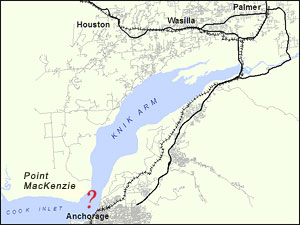Leaders of Government Hill, UAA Economist Scott Goldsmith, and community representatives held a press availability today and released the following information:
Last month the Federal Highways Administration approved the KABATA’s expenditure of $15 million in right of way funds even though the project has no financing plan and the Record of Decision remains in court while the Municipality of Anchorage and the Knik Arm Bridge and Toll Authority (KABATA) seek to negotiate right of way through the Port. For a copy of FHWA’s release of funds form, click here.
Government Hill property owners are receiving notice from KABATA that their property requires appraisal as a first step toward sale or condemnation, for a copy of August 19, 2011 letter from KABATA to a resident, click here.
Right of Way maps from KABATA are available. To view the Anchorage side ROW maps, click here. To view the Mat-Su ROW maps, click here.
Anchorage’s existing Long Range Transportation Plan (LRTP) 2027 incorporates the conditions the Anchorage Assembly made when the Knik Arm Crossing Bridge was added to the LRTP, only if no further state and local funds were needed and also requiring that a financial plan would be in place before construction activities took place. Government Hill Community Council President Bob French said the Mayor, AMATS and Assembly appear not to have been notified of the end run by FHWA and KABATA to go ahead with Right of Way acquisition without meeting the LRTP conditions. For a copy of the key conditions the Anchorage Assembly attached to the Bridge project in the LRTP, click here.
Scott Goldsmith of the University of Alaska’s Institute of Social and Economic Research (ISER) noted that the ISER/Ch2M Hill forecast for Bridge traffic in 2035 was 17,700 trips a day while KABATA’s traffic consultant Wilbur Smith and Associates projects 36,000 trips a day in 2035, a number that is the basis for KABATA’s optimistic toll revenue forecast in their financial plan. The Technical Advisory Committee of the Anchorage Metropolitan Advisory Committee had requested KABATA to provide the Traffic Analysis Zone (TAZ) data that would help AMATS sort out the consistency and potential accuracy of the different population and traffic estimates. It was announced at the AMATS Technical Committee yesterday that KABATA has decided not to release the TAZ data, at $3,000 to release the data, and $10,000 to answer questions on how they came up with the predictions, KABATA decided it was just too expensive.
For the power point presentation to the AMATS Technical Advisory Committee by Scott Goldsmith and financial analyst Jamie Kenworthy (Goldsmith slides labeled, unlabeled are Kenworthy) please click here.
Finally, a statewide poll by Ivan Moore was released. The poll was taken of 621 registered Alaskan voters in June, 2011 before the Municipality suit on the right of way and before recent publicity that if the KABATA bills before the legislature are passed, the state would be responsible for making up any shortfall in toll revenue. The poll showed that by a narrow majority, Alaskans approve construction of the Bridge but when asked if they support an additional $150 million of State Funds for the Bridge or a state guarantee for KABATA, the two key features of the KABATA bills before the legislature, a strong majority of Alaskans across political affiliation and geographic regions oppose further state support for the Bridge. For a copy of the poll, click here and for Ivan Moore’s statement, click here.


